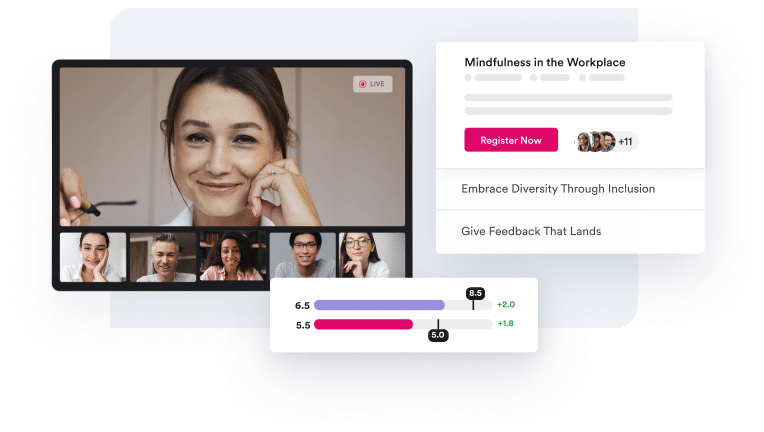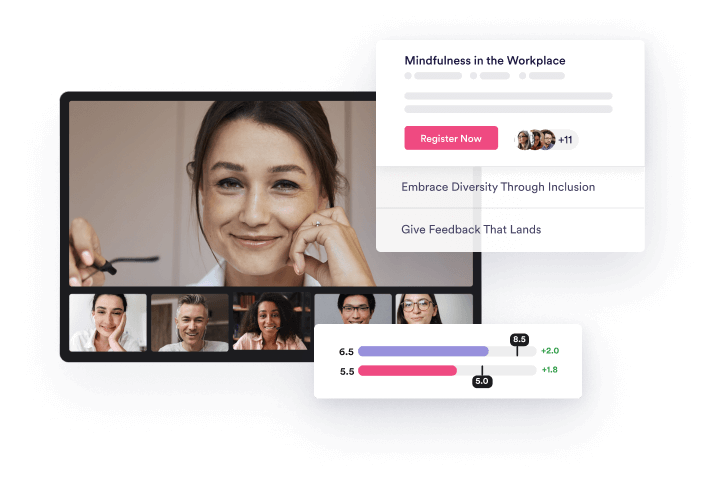Learning is rarely time-bound. Even if we go to school, attend a conference, or read a book to expand our knowledge and skill sets, we don’t stop learning after we graduate, return home, or turn the last page. Instead, we continue to grow and hone these new and existing skills over time; practicing and practicing until we grow more comfortable in our abilities.
That process is called continuous learning and organizations would benefit from paying attention to this ongoing learning mentality. Even now, many businesses still treat learning and development (L&D) initiatives as one-off classes that fail to create lasting behavioral change in employees. Instead, businesses need to consider how to build a progressive workplace learning strategy that builds upon previous classes and training programs to encourage employees to truly embrace, retain and expand knowledge over time, rather than for a brief temporal moment following a class.
Read on to learn what continuous learning is, its benefits, and how your organization can create a workplace culture that prioritizes ongoing professional development.
What is continuous learning?
Continuous learning is the process of learning new skills and knowledge over time. You may hear the term used interchangeably with lifelong learning or constant learning, but they all mean the same thing.
While some learning is time-bound, like grade school which begins on your first day of school and concludes upon graduation, continuous learning does not have a start and end date. It’s a lifelong process of refining existing expertise and picking up new abilities along the way.
In the modern workplace, there are many ways to foster a culture of continuous learning. While some continuous learning can be employee-initiated—like if a marketer decides to spend a few hours a week learning to code, for example—in reality, very few individuals actually make time for upskilling and professional development during the workday on their own. For this reason, many businesses develop internal training programs or partner with outside vendors to train their teams on the most in-demand skills. That helps lower the barrier of entry and encourages more employees to carve out time in their busy schedules to prioritize their own growth and better themselves.
What are the benefits of continuous learning?
Investing in continuous learning can have many benefits for both your employees and your business. Here’s a look at some of the top reasons your company should make continuous learning a top priority:
Develop employees’ careers
Your employees are your business’s most important resource. Creating a culture that celebrates lifelong learning can show them that your business cares about their careers and is invested in their future. When your employees grow with your company, they feel a stronger sense of connection to your business and mission. That helps you retain talent and ensure your employees lead long, fulfilling careers with your business.
“At Hone, we help some of our most innovative customers leverage our virtual instructor-led training (VILT) programs as full-career-cycle recruitment and retention strategies,” shares Hone’s Learning Solutions Strategist Meica Hatters, MHRM, MS, SHRM-CP, PHR. “One organization even added our Manager 101 program description to their recruitment materials, as proof that they are dedicated to their employees’ development not only when they join, but over the full lifecycle of their careers there. Training is more than a one-off event at these types of organizations, it is part of their culture.”
Increase employee confidence and loyalty
When your employees learn new skills and see their personal progress first-hand, they can feel better equipped to succeed in their roles. This can lead to employees becoming more confident in their abilities and thus more engaged or even productive.
Plus, when your employees attribute their growth to your business via a company-paid professional development stipend, internal mentorship program, or even on-the-job learning, they are more likely to think fondly of your company. This can lead to increased employee loyalty and even help reduce turnover.
Improve talent retention
Investing in professional development can actually help your organization lower attrition and keep top talent. One of the leading reasons employees leave jobs is because they feel their current role or organization lacks growth opportunities. Building ongoing training programs and having clear career paths can help your organization head off these concerns and help your employees envision a long, fulfilling career with your business.
In fact, according to LinkedIn’s 2019 Workplace Learning Report, 94% of employees say they would stay with a company longer if it invests in their learning and development. Plus, the same study found employees at companies with high internal mobility stay 2X longer than those who don’t. Clearly prioritizing ongoing professional development is a worthwhile investment for your company.
Future-proof your organization
The modern workplace is constantly evolving, and with it comes new challenges employees need to be prepared to handle. To ensure your employees have the right skills to overcome such challenges in the next 1, 5, or even 10 years, your business needs to invest in continuous learning today. Ensuring employees have time to learn and hone both hard and soft skills will help your business be more adaptive and set you up to succeed not just in the present, but also in the future.
How can your business support continuous learning?
Continuous learning programs look different in every organization. No one knows your employees quite like you do, so you’ll need to decide what continuous learning programs and initiatives are the best fit for your team and business. That said, here are some common ideas to help you create an effective continuous learning strategy:
1. Have ongoing career development conversations
An employee’s career development shouldn’t be a bi-annual conversation during review season. Managers should regularly discuss career development opportunities and interests with their direct reports so they can better understand their reports’ goals and know how to properly coach and support their em ployees. This can help managers push their teams to pursue a class, take a leadership role on high-visibility projects, or find a mentor within your organization.
ployees. This can help managers push their teams to pursue a class, take a leadership role on high-visibility projects, or find a mentor within your organization.
2. Make time for learning
Professional development shouldn’t be after-hours homework. Your business must encourage employees to make time to grow their skills and knowledge during the workday if it wants people to truly make time for growth. Only then will your employees have the flexibility and support they need to reserve recurring time in their day to invest in their careers.
3. Give employees the freedom to experiment
Teaching employees new skills is important, but unless they have time to put these skills into practice, their new knowledge will quickly fade. For that reason, your business needs to build both a culture of continuous learning and a culture of experimentation. When employees have the freedom to learn and apply their new knowledge to their work, they can grow and prosper. On the other hand, if your workplace culture is too focused on output and hitting targets that your employees are discouraged from trying new things, your learning strategy and effectiveness will suffer.
4. Train your managers
Managers play the largest role in shaping the workplace experience for your workers, so they need the skills to properly support their teams. Ensuring new and existing managers have the people skills to motivate their team, host effective meetings, delegate effectively, and give feedback will help them better coach their teams and push their reports to grow professionally.
It’s a well-known fact that a one-size-fits-all approach to training is rarely effective. Every organization has a unique culture, set of values, and collection of policies—all of which impact how receptive your managers will be to your trainings. Truly effective training programs need to be personalized to these elements of your organization’s identity in order to truly resonate with your learners and drive lasting behavioral change, according to Hatters.
“Honestly, you can deliver great training content, but if the case studies and examples aren’t relevant to the organization’s culture, the skills won’t stick,” Hatters says. “Businesses must work with learning leaders to customize speaker notes and case studies to incorporate an organization’s values, goals, and challenges to ensure a course is truly relevant to learners.”
If you’re looking to upskill your managers, Hone offers a variety of live online learning classes for both new managers and experienced people leaders. Speak to a member of our team to learn more about corporate memberships for your team.
“You can deliver great training content, but if the case studies and examples aren’t relevant to the organization’s culture, the skills won’t stick.”
— Meica Hatters, Hone
5. Offer classes
Lastly, and most obviously, offer a way for your employees to learn! Again, you know your employees best, so be sure to pick a learning strategy that works best for your workforce. There are three main continuous learning program styles you can choose from:
- Classroom learning: Employees learn together in person and benefit from having an instructor present in the room to review challenging concepts and answer questions
- E-learning: Employees can learn asynchronously and at their own pace with self-directed online learning
- Live online learning: This learning style combines the community aspects of classroom learning and the flexibility and scalability of e-learning to give employees an effective new way to learn
Regardless of which learning style you choose, just make sure you communicate to employees that your business offers such a solution. After all, offering these classes and learning opportunities won’t benefit anyone if your employees don’t participate in them.
Using Hone to promote continuous learning
Ready to build a culture of continuous learning at your organization? Hone is here to help. Our live online learning platform allows your employees to enroll in classes relevant to their interests and roles at a time that works best with their busy schedules. Employees can attend classes from anywhere and benefit from learning alongside like-minded peers from all over the globe.
Talk to a member of our team to learn how Hone’s unique platform can bring continuous learning to your organization today.








